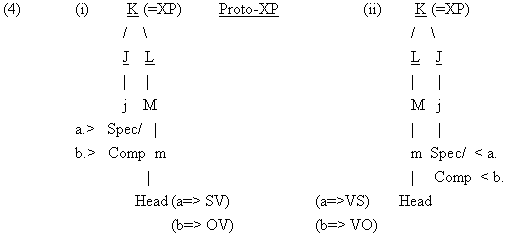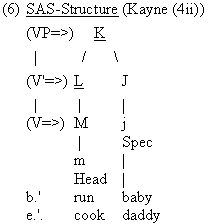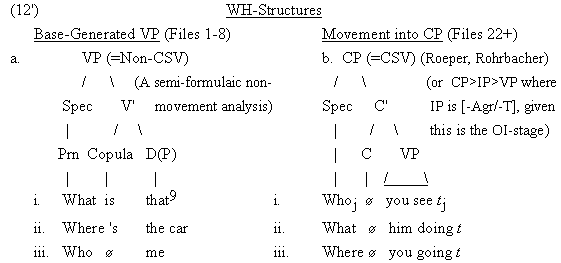
Towards a Weakening of Continuity: Joseph
Galasso
0. Introduction In (§1) I argue that Kayne's strong position for a universal Spec>Head>Comp (SVO) Word Ordering as based on his LCA needs to undergo some modification in order to account for SV/OV vs. VS word order variations found among the initial (Single Argument String (SAS)) Stage: a stage arguably restricted to thematic/base-generated projections which would exclude any movement operation (per se). In (§2) I argue that the strong stance taken by Wexler (et al.) (i.e., defining the child's initial Optional Infinitive Stage as Stage-1) needs to be 'weakened' and relegated to being a second stage. The Stage-1 I am proposing here lacks all signs of such Optionality (regarding Tense and/or Agreement). Furthermore, (following Radford ms. 1998) I will argue that a (previously unreported) symmetry holds concerning the protracted emergence of two INFL-related constructs: namely, the development of IP(Agr) as it pertains to (i) Subject+Verb and (ii) Possessive agreement (cf. Kayne 1994: 105). In (§3) I argue that Cinque's strong stance regarding a universal Spec-CP landing site for (all) Operator/Wh-elements needs to be slightly 'weakened' (favoring the Structure-Building model) by allowing the very early Wh-element of Non-CSV constructs to be potentially base-generated in Spec-VP where they can either take-on the Q-role of a miscategorized subject pronoun and/or a quantifier. Our modified version suggests that it is only with the emergence of CSVs--when the Spec-VP is filled by an overt subject--that Cinque's universal Spec-CP account applies (truncations notwithstanding). The aim of this paper is not to reject outright innate Continuity Principles of the three theorists, but rather to demonstrate that though their overall intentions are sound, I believe there is room to maneuver a 'weakening' of their approach without jeopardizing the spirit of their proposals. The empirical findings that force this weakening favor a 'bottom-up' model of acquisition where, as defined, children first pass through an initial Pre-Functional Stage (utilizing thematic-VPs to the fullest extent), and only later come to form an Optional Stage (where more complex functional IP/CPs sporadically appear). 1. Word Order & VP Considered: Kayne In Kayne's hierarchical model, the Complement position is seen as playing the pivotal role in determining Word Order. This strict linearization is achieved by virtue of LCA--as triggered by the Complement's maximal projection within the Head-Comp configuration.
More precisely, it is the insertion in (1) of a maximal-projecting
N-node of the Complement--breaking the unwanted symmetry
of L [M,P; m,p] as seen in (2)--which renders the correct antisymmtrical
hierarchy. The principles of the hierarchy are based upon the Linear
Correspondence Axiom (LCA). In short, the axiom states that an asymmetric
c-command relation (ACC) imposes a linear and hierarchical ordering
of terminal elements (from left-to-right): viz., nonterminals K,
L, N as seen in (1). The central workings of the ACC
lie within the Head-Comp relation, and for that reason alone, an
additional (VP-internal) maximal projecting node N of the
Comp is required, bringing about an asymmetric left-to-right hierarchical
structure. In addition to the LCA and ACC, Kayne makes one additional stipulation, and it is eventually this final stipulation that allows us to envisage a 'weakening' of the model: (3) Head Medial Principle = <x,y / y,x > ( x=Head) (Kayne 1994: 35) The Head Medial Principle states that a Head <x>, in theory, can project universally either in an initial or final position prior to the combined onset of the Specifier-Complement string <y, z> (which would form a Double Argument String (see below)). Such a principle could be reduced to saying that when a solitary argument projects (i.e., an external Specifier), it opts to project either to the left or to the right of the Head <x>, dependent upon where (in the target grammar) the Complement would naturally place itself, thus yielding potential SVO or OVS base-generated word orders (viz., SVO iff Comp sets rightward, OVS iff Comp sets leftward (see Tonoike 1995 for OVS). In sum, by stipulating that all Heads must be base-generated in medial position, we deduce that there exists a Complement Parameter (in relation to Spec) which endeavors 'to set' the Comp either leftward or rightward of the Head--the Spec is then seen as eventually positioning itself accordingly within the given DAS (=Double Argument String) structure. This essential means, and here is the precise 'weakening', that there are (as mentioned above) two universal orderings, not one: SVO, along with the mirrored OVS (with principles of the hierarchy remaining intact). We conclude that it is the onset of the DAS stage with the co-emergences of Spec along with Comp that tiggers Kayne's weakened version of his LCA. Before the onset of DASs (i.e., the initial stage where MLUw < 1.75 and where SASs are in the vast majority) the XP is considered to be of a partially fledged Proto-Type, enabling Subjects and Objects alike to enter into the sole proto-argument position.3 From this, we can deduce that a further hierarchy of theta-role visibility exists. (i) The first argument of a verb is given (by default) a proto-external argument status. (ii) Once a second argument of the verb is syntactically projected, (catapulting the full-fledge XP along with its 2nd and 3rd level projections), both External/Internal Mechanisms (for theta-marking) become operational forcing the Subject/Spec now to solely occupy the external position--leaving the Object to properly insert under Comp. Consider the (SAS) reduced trees in (4) below (cf. 1) where the Spec/Comp is now 'reorganized' and fused as the sole potential (external) argument--noting that the ordinal Comp projection which is said to be responsible for the asymmetry is not salient.4, 5
(5) Table 1.1
2. Optional Feature Specification & IP Considered:
Wexler Generally speaking, two-and-three year old children pass through
a stage during which they sporadically omit inflections. Wexler
(1994) has termed the stage as the Optional Infinitive
stage. I know of no controversy to this well known fact of Optionality.
The matter at issue here lies in exactly defining where such a stage
begins. That is to say, although 'Structure-Builders' do acknowledge
an OI-stage, they do so not of the demise of their Structure-Building
account. In contrast, proponents of Full Competence Hypotheses have
claimed their stake on this OI-stage as providing the last piece
of evidence against any Structure-Building model, claiming the stage
proves all structure to be in place from the very earliest MLUw.
With regards to the occasional grammatical blunder, the child is
merely said to 'underspecify' that feature responsible for Heading/Projecting
the Category/Phrase in question--with the overall structure remaining
intact and unhindered. Consider the Tables below along with the relevant Token Examples showing the acquisition of Inflective "S" (Main Verbal and Possessive Nominal).6 (7) Table 2.1
(7') Token Examples The data above point to a symmetric acquisitional process of both
types of INFL-related "S" (Possessive and Verbal) and
clearly indicate a stage where such INFL-related phenomena are altogether
absent. Radford (et al. ms. 1998: 2) picks up on this parallel by
recounting Kayne's (1994: 105) attempt to link one overall INFL-related
mechanism for dealing with both (i) Subject+Verb and (ii)
Possessor+Noun Agreement constructs. In short, the account basically
runs as follows. Kayne considers that the Possessive "S"
along with the Verbal "S" share the same reflex of an
Agreement relation between an inflectional Head and its Spec, utilizing
the following paradigm as follows: (9) An Overall Inflectional "S" Reflex Poss:
a. [D/Po[IP
Daddy [I 's [+Agr]] turn] ] (=Gen. cf. (ii),
cf. Kayne) One could interpret Kayne as follows: since both Verbal and Possessor "S" encode an Agr(eement) relation (under IP), the overall omission of the inflection "S" suggests there to be an Agr failure of some kind (coded as (-Agr)). The symmetry that we discover between the onsets of both Verbal and Nominal/Poss. INFL "S" indicates (prima facie) that a correlation holds between the two structures--since the same Spec-Head Agreement relation is ultimately involved. Tables 2.2, 2.3 illustrate the incremental acquisition of Possessor Agr(eement)/INFL: (10) Table 2.2
(10') Token Examples (11) Table 2.3 2/3Per Poss INFL: Required contexts Age You (-Agr) vs. Your (+Agr) // Him (-Agr) vs. His (+Agr) i. 3;2-3;4 n. 14/16 (88%) 2/16 (12%) -------------------------- ii. 3;6 2/29 (7%) 27/29 (93%) 10/13 (77%) 3/13 (23%) (11')
Token Examples What we can deduce from the above findings is the following. First, the general picture suggests (contra Wexler's notion of an initial OI-Stage) that, in fact, the initial Stage is without Inflection (irrespective of potential INFL optionality).8 The data presented here give some evidence that a Pre-Functional and Pre-OI-stage does exist--characterized by the fact that (i) presumably Agr settings of early constructs consistently get Objective Case via Default (-Agr), (ii) there is no use of inflective "S" for either Subject+Verb or Possessor Agreeing constructs. Functional categories seem only to manifest at a slightly later Stage-2 (albeit with Optional-Underspecification). Following Radford (et al. ms 1998), we moreover can conclude from these findings that a previous unreported symmetry seems to hold regarding the acquisition of all INFL-related constructs 'across-the-board': viz., between Pronominal Possessors and Subject+Verb constructs. Overall, the findings clearly point to a two-stage developmental process of Language Acquisition: (i) a Pre-Functional/Pre-Optional Infinitive Stage-1, and (ii) a Functional/Optional Stage-2 (which Radford (op.cit.) appropriately terms the Optional Inflection stage). (Stage-3 marks the eventual mastery of the target grammar).
(12) Table 3.1 Wh-element surface positions a. Non-CSV b. Wh-Spec-CP (e.g., What is that? // What him doing?) i. Files 1-21 n.= 78 0 ii. Files 22-25 120 80 The above defining characteristics of a potential VP (Non-CSV) Wh-structure bears its origins in the early literature: (e.g., Klima & Bellugi 1966, Brown 1968, Bowerman 1973). More recently, research into such early child structures have commonly shown that under-two year olds may rely on a thematic grammar and may not be capable of performing movement operation (per se). Thus, young children may initially be forced into projecting (all) strictly from out of the thematic-VP (be it an SVO or OVS ordering). This amounts to saying that under two-year olds may not form IPs nor CPs, since both phrases would require some sort of movement operation. Regarding CPs here, we follow Chomsky (1986b: 42)--the spirit of which could be extended to his later writings on Minimalism (1995)--and take true Wh-movement as that which includes either Wh-frontings/Traces, Aux. inversions, or CSVs (noting that all such criteria for movement are completely lacking for Stage-1). The main thrust behind this section is that initial Wh-Non CSV constructs show no signs of movements as such, and hence, could, in theory, be considered as simple VPs. The argument is two pronged in nature: (i) The Wh-element may project (base-generated) from an available Spec-VP site (in a bottom-up manner) since there is no overt Subject filling the slot; (ii) as a consequence, Agreement and/or Case may typically get mis-spelled in a way which suggests the (thematic) Wh-word to be taking-on the role of the superficial subject of the clause (e.g., What's these?/Who is him?). Hence, the Wh-Spec-CP analysis (cf. Cinque) results by way of an overt-lapping subject competing for the proper Spec-VP slot, forcing the Wh-word to then preposition itself into Spec-CP. Regarding the mis-spelling of Case and/or Agreement, the underlying Subject of Non CSVs e.g., Who is me? (=Who am I>I am who?) consistently shows the Wh-element as not functioning as the complement of the verb, but rather as the superficial 3SgPres Subject of the Copula. (NB. These errors last well until the emergence of CSVs.) Moreover, Radford (1996: 59ff) reports that there is further semantic evidence (coupled with the syntactic evidence) suggesting that children treat Wh-words of such NonCSVs as (unbound) Subject Determiner-Quantifiers (as opposed to prepositioned complement (bound-variable) Operators). Radford (1990: 130) had once cited such data regarding early Wh+Copula constructs and noted that children often misanalyzed the Wh-item of adult interlocutor questions into the following thematic scheme e.g., [What=>What's X?]: (13) What's she [=Nana] doing? (adult)---Nana (child).
END NOTES 1 Citing Kayne, R. (1994), Wexler, K. (1994), and Cinque, G. (1990). 2 Such an initial stage which manifests no formal syntactic features however may be exceedingly short lived (and thus unobservable or silent, cf. Roeper 1992: 340) for some children of very morphologically rich languages (e.g., Italian). The OI-stage for such languages might manifest itself from the very earliest MLUw. Such early manifestations however don't in any way jeopardize the Structure-Building model (which doesn't argue, in principle, against a possible OI-stage), but rather, it merely addresses the notion that Italian children may simply workout their Inflectional Paradigm in a minimal amount of time--and so any potential Pre-Functional/Pre Optional Infinitive stage may seemingly pass undetected in a silent stage. However, a caveat is in order here: it remains uncertain whether such languages, in fact, do not exhibit an initial Pre-Optional stage. For instance, a number of richly inflectional languages--namely Polish (Smoczynska 1985), French (Pierce 1989), and Dutch/German (Wijnen & Bol 1993)--have indeed been reported on as having an identifiable Non-Inflectional stage-1. (See Atkinson (ms 1995: 51-ff) for a commentary on the viability of a Pre OI stage for such languages.) 3. Besides Bowerman's initial study (loc.cit.), other prima facie evidence found in the acquisition literature can back-up the claims being made here. E.g., Irish data reported on by Hickey (1992: 11) suggest that otherwise variable word ordering found among SASs becomes rather fixed once DASs appear: (Eoin: n.= 86% VS, vs. 14% *SV, vs. 0% *SVO). Tsimpli (1992) likewise demonstrates, cross-linguistically, that indeed a correlation seems to hold between variable orderings found at the VP stage (contra fixed ordering at the IP stage). Furthermore, reports taken from Clahsen (1986) suggest German children produce incorrect OV orders over 50% of the time (subject optionally projecting). The onset of obligatory subjects coincides with 90% correct ordering. 4 We consider at this very early stage that all missing arguments (such as PRO) are lexically and/or syntactically saturated (cf. Rizzi 1986) (contra null analyses) and thus, being implicit, need not require syntactic projection--hence, empty categories needn't be hosted. (See Radford 1990 for comments.)
6. I have excluded from this count potential routine formulaic 3PSg Copulas found at stage-1: (e.g., "What's +N", '"Is+N", etc) where the frame consists of a fixed item plus a variable. Criteria for identifying such formulaic frames are taken from Hickey (1993). See also Peters (1983, 1995). 7 Following Schütze (1997), I assume that the 3perSg "S" marks both (fused) Tense and Agr. (I however argue against this position in my Ph.D. Dissertation (1999) where I suggest that "S"solely marks Tense.) Nothing hinges on this distinction however--one could argue that the Pollockian split IP (T and Agr) amounts to the same INFL reflex. The idea here is that stage-1 is without IP (in both T and Agr form). 8 Of course, the outstanding dilemma faced with this view, as seen through the eyes of Wexler, is that such data which bear out no INFL-related material could simply be dismissed as pertaining to a 'one in the same' OI-stage--where the lack of apparent optionality gets disclaimed as an innocent by-product of insufficient data collecting, recording, etc. The problem with this stance is that it simply becomes ridiculously impossible to dispute an OI-stage with empirical data--i.e., whatever data one presents contra the OI-stage wouldn't stand a chance from the empty rhetoric of such indisputable "neither here nor there" ideology. Worse still, is the scenario where a stage-1 would be characterized as an 'obligatory non-specification stage' and where functional categories would be obligatory present albeit always null). Quite clearly, I see no logical reasoning behind projecting an IP if all of its feature specifications are thereafter obliged to remain null and void? The prevailing reasoning surely must consider the empirical date alone at this point. 9 The Copula "Is" is the only verb form that appears among such Non-CSV constructs: In concluding that such early constructs fail to generate an IP, we resort to considering them as semi-formulaic in nature. From this analysis, it follows that their highest potential projection consists of a base-generated VP. There are no reported instances of Verbal 3SgPres "S" or Bare Verbs showing up among Non-CSVs. 1st/2nd Pers Copulas (am, are) don't show until file 24. No other material that could possibly suggest an IP/CP stage appears at this stage-1: i.e. no Aux Invert, surface wh-raising above Subject, Do-insert. (See §5 for caveat). |
||||||||||||||||||||||||||||||||||||||||||||||||||||||||||||||||||||||||||||||||




